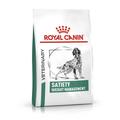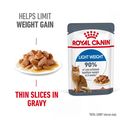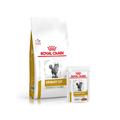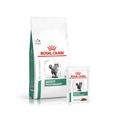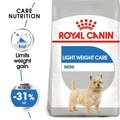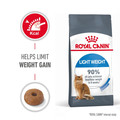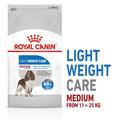Is my pet a healthy weight?
As a responsible pet owner, it is a great idea to regularly speak to your veterinary practice about your pet’s weight to ensure they are maintaining a healthy weight and shape. The good news is that if things aren’t quite on track, it’s never too late to act and have a positive impact on their body condition and quality of life. Many veterinary practices are happy for you to pop in to use the scales and qualified, registered veterinary nurses frequently run weight clinics offering excellent advice and support.
As well as weighing your pet, your veterinary practice will be able to show you how to body condition score (BCS) to help you recognise if they are under, over or at ideal weight. As every cat and dog is an individual, BCS assesses their shape by looking at and feeling three areas of the body; feeling the ribs, waist definition and how obvious their abdominal tuck is. If your pet is at ideal weight and shape, you should be able to easily feel their ribs using a feather-like touch, be able to see and feel the indentation of their waist behind the ribs and see an obvious abdominal tuck. If you must apply pressure (even slightly) to feel their ribs, or you can’t see or feel their waist indentation, then there is a strong likelihood your pet is not in ideal shape and it’s time to get help.
Latest Stats:
Obesity is recognised as the most common nutritional disease in dogs and cats. In the UK the prevalence of pet obesity is increasing, with around 65% of all dogs1 and 39%2 of all cats now overweight or obese. Even more worryingly, it’s been estimated that 52%1 of young dogs (between 18-24 months of age) are overweight, putting them at greater risk of struggling with obesity throughout their lifetime. The number of overweight or obese pets seen in both day-to-day life and via social media channels means that an overweight body shape has become normalised, and it can make it more difficult for pet owners like yourself to know if your pet is at ideal weight and shape or not, but the good news is there’s lots of help available!
What is the impact of my pet being overweight or obese?
Having obesity puts your pet at an increased risk of developing other medical conditions such as joint disease, diabetes mellitus, urinary disease, skin disease and tumours1. If your pet is overweight, you might spend more on health care costs compared to owners whose pets are at an ideal weight3 and obesity may even shorten your pet’s life expectancy. Long-term studies indicate that overweight dogs may live up to 2.5 years less than dogs of a healthy weight4 and overweight cats may live up to 1.9 years less than cats of ideal weight5.
Prevention is better than cure!
With a significant proportion of young dogs already classed as overweight, it’s vital that awareness of a healthy weight starts early so it can be maintained. Fat cells are created during the growth phase and once there, they never go away, they can only shrink and expand. This means that overweight puppies and kittens are much more likely to be overweight or obese adults7 so keeping a close watch on their body condition is essential. If you have a puppy or kitten, speak to your veterinary practice about the growth charts now available, as developed by the Waltham Petcare Science Institute8, to help you both track their growth to ensure they stay on the right track. Always ensure you’re feeding an appropriate growth diet relevant to your puppy or kitten’s age and expected adult weight and ensure you seek guidance from your pet food manufacturer for any queries on feeding amounts.
Once your pet is neutered, speak to your veterinary practice about how to adapt their nutrition as pets may experience an increase in appetite when in fact, they require less calories (energy) than before they were neutered. If their nutrition is not adapted, this can put them at greater risk of weight gain.
Tips for maintaining a healthy weight:
-
Use feeding guidelines on packaging to help work out how much food to feed and if in any doubt, contact your pet food manufacturer for help.
-
Weigh daily food portions on digital scales as studies have shown measuring cups or scoops to be inaccurate; the results ranged from under-feeding by 20% to over-feeding by up to 80%!6.
-
If you use food as a reward or treat, remember that these calories can easily add up. Any extra treats or food rewards should make up no more than 10% of your pet’s daily food allowance. It’s a good idea to use part of their measured daily food allowance for rewards.
-
Start using interactive, puzzle feeders to feed your pet rather than traditional bowls. They help to slow down fast eaters but also provide an opportunity for some extra mental stimulation. There’s a wide variety available for both cats and dogs but you can also use homemade ones.
Hopefully by reading this, you’ll agree that a healthy body weight and condition for our pets really does matter. Regular weighing and assessing your pet’s BCS are a great start in helping to maintain them at ideal body weight and if after reading this you have any concerns, please speak to your vet, pet professional or pet food manufacturer who should be happy to give you advice and support.
For more information from ROYAL CANIN®, please visit the following pages; for dogs (Dog Weight Management | Royal Canin UK - Royal Canin) and for cats (Cat Weight Management - Royal Canin - Royal Canin).
References:
-
Exercise is an important aspect of a pet's health, both for the physical and mental benefits. Are there ways you could increase your pet’s movement? Exercise isn’t just for dogs, play sessions with cats (not just kittens!) can be very successful in increasing activity and enjoyable for you and your pet.
-
German, A.J., Woods, G.T., Holden, S.L., Brennan, L. Burke, C. (2018). Dangerous trends in pet obesity. Veterinary Record; 182 (1).
-
Courcier, E.A., O’ Higgins, R., Mellor, D.J., Yam, P.S. (2010). ‘’Prevalence and risk factors for feline obesity in a first opinion practice in Glasgow, Scotland.’ Journal of Feline Medicine and Surgery, 12 (10), pp. 746-753.
-
Lomberg, E., Birch, L., Endenburg, N. et al (2017) The financial costs, behaviour and psychology of obesity: a one health analysis. J. Comp. Path 156: 310-325.
-
Salt, C., Morris, P.M., Wilson, D., et al (2018) Association between life span and body condition in neutered client-owned dogs. J. Vet. Intern. Med: 1-11.
-
Teng, K.T. et al. “ Strong associations of 9-point Body Condition Scoring with survival and lifespan in cats.” J. Feline Med Surg 2018; 1-9
-
German, A.J., Holden, S.L., Mason, S.L., Bryner, C., Bouldoires, C., Morris, P.J., Deboise, M., Biourge, V. (2010). Imprecision when using measuring cups to weigh our extruded dry kibble food. Journal of Animal Physiology and Animal Nutrition 95 (3): 368- 373
-
Leclerc, L., Thorin, C., Flanagan, J. et al (2017) Higher neonatal growth rate and body condition score at 7 months are predictive factors of obesity in adult female Beagle. BMC Veterinary Research 13 (104).
Written by: Royal Canin (Guest Author)

